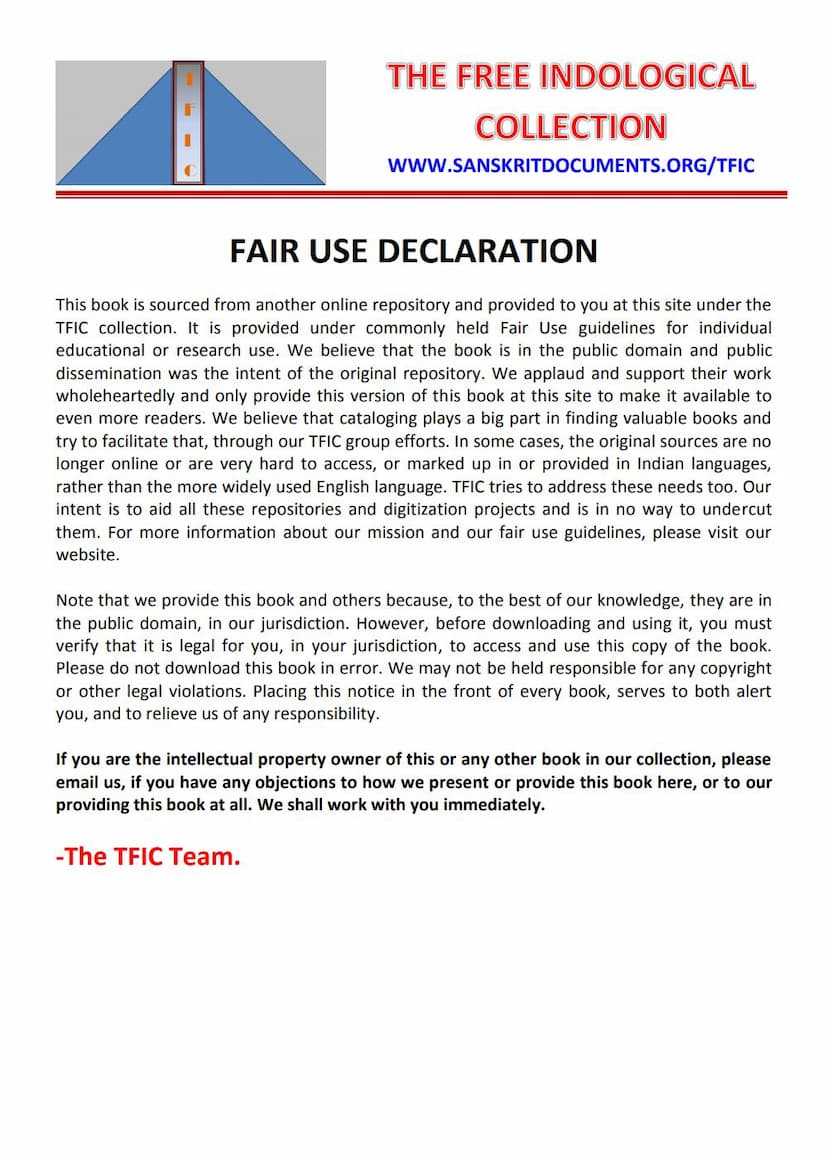Jain Chitra Kalpadruma
Added to library: September 1, 2025

Summary
This comprehensive summary outlines the key aspects of the Jain text "Jain Chitra Kalpadruma" by Sarabhai Manilal Nawab, based on the provided pages. The book is a collection of representative examples of Jain art in Gujarat from the 11th to the 20th century.
Book Overview:
- Title: Jain Chitra Kalpadruma (Jain Art Kalpadruma)
- Author/Editor/Publisher: Sarabhai Manilal Nawab
- Publisher Location: Ahmedabad
- Publication Year: Samvat 1992 (Vikram era), which corresponds to 1935 CE.
- Objective: To present the art and history of Jain art in Gujarat to the Gujarati public, focusing on illustrations from manuscripts.
- Dedication: The book is dedicated to Shrimant Sarkar Maharajshri Sir Sayajirao Gaekwad, highlighting his patronage of Gujarati literature, culture, and architecture.
- Foreword & Introductory Note: The book features a foreword by Prof. W. Norman Brown of the University of Pennsylvania and an introductory note by Dr. Hiranand Sastri, who was overseeing Mr. Nawab's archaeological training.
Key Themes and Content:
-
Jain Art of Gujarat: The book's primary focus is on showcasing the rich artistic heritage of Jainism in Gujarat. It covers various forms of art, including:
- Manuscript Painting: This is the central theme, with numerous illustrations from Jain religious texts. The paintings range from the 11th to the 19th century.
- Woodwork: The book details Jain woodwork found in temples in Patan, Khambhat, and Surat, highlighting intricate carvings.
- Calligraphy (Lekhanakala): The book includes a section dedicated to Jain calligraphy and the evolution of scripts, emphasizing its connection with manuscript illustration.
-
Historical Periods Covered:
- Manuscript Art: Primarily from the 11th century to the 19th century (Vikram era 1157 to 1950).
- Woodwork: Mentioned from the Mughal period and earlier.
- Calligraphy: Discussed in the context of its development alongside manuscript art.
-
Content Breakdown:
- Dedication & Forewords: Setting the tone and context of the work.
- "Nivedan" (Statement/Preface): Sarabhai Manilal Nawab explains his motivation for undertaking this extensive project, stemming from an exhibition of Jain literature and art. He expresses gratitude to numerous individuals and institutions for their support.
- Articles by Scholars: The book includes essays by prominent scholars:
- Muni Shri Punyavijayji: On "Indian Jain Shraman Culture and Calligraphy."
- Rasiklal Chhotalal Parikh: On "Ancient Jain Art Principles."
- Ravishankar M. Raval: On "Medieval Painting of Western India."
- Sarabhai M. Nawab: On "Gujarati Jain Art and its History."
- Other contributors: W. Norman Brown, Dr. Hiranand Sastri, Dolatray Rangildas Mankad, Manjulal Ranchhodlal Majmudar, and others who provided specific articles and insights.
- Table of Contents (Anukramanika): Outlines the structure of the book, covering calligraphy, painting, and historical aspects of Jain art and culture.
- List of Illustrations (Chitranukram): A detailed index of all the illustrations provided in the book, referencing specific manuscripts and themes. This section is extensive, listing hundreds of individual paintings.
- Calligraphy Section (Lekhanakala Vibhag): This section delves into the history, tools, and evolution of Jain scripts, emphasizing their integral role in the visual presentation of manuscripts.
- Painting Section (Chitrakala Vibhag): This is the core of the book, featuring a wide array of Jain paintings from various manuscripts, covering religious narratives, deities, historical figures, and decorative motifs. Special attention is given to the stylistic evolution and regional variations.
- Glossary/Abbreviations (Sankshepni Samaj): Explains abbreviations used for referring to various Jain manuscripts and collections.
-
Artistic Styles and Features:
- Early Western Indian Style: Mentioned as a significant style represented in the miniatures.
- Persian Influence: Some manuscripts show Persian characteristics in subsidiary side scenes, often blending with Indian styles.
- Marginal Ornaments: The book showcases intricate marginal designs and floral patterns, highlighting the mastery of Gujarat artists.
- Iconography: The work includes illustrations of deities, Vidyadevis (goddesses of knowledge), and Tirthankaras, providing valuable iconographic information.
- Technical Aspects: Information is presented on painting techniques, lettering, and manuscript preparation.
- Realism and Naturalism: The book highlights the artists' ability to capture lifelike details in figures, even in stylized representations.
- Use of Colors and Materials: Descriptions often include the specific pigments and materials used, such as gold and silver ink.
-
Key Manuscripts and Collections:
- Manuscripts from various Jain "Bhandars" (collections) in Patan, Ahmedabad, Baroda, and other locations are featured.
- Notable manuscripts include illustrations from the Kalpasutra, Kalakacharya Katha, Nishithachurni, Sangrahani Sutra, and Vasantvilas.
- The collection emphasizes the artistry found in palm-leaf manuscripts as well as those on paper.
-
Historical Context and Patronage:
- The book emphasizes the role of Jain monks, community leaders (Seths), and patrons in preserving and promoting Jain art.
- It touches upon periods of decline and revival in Jain art and scholarship.
- The influence of rulers like Maharaja Siddharaja Jayasinhadeva and Maharaja Kumarpala is highlighted, as is the patronage of Maharaja Sayajirao Gaekwad.
Significance of the Book:
- Preservation of Heritage: "Jain Chitra Kalpadruma" serves as a vital record of Jain artistic achievements in Gujarat, many of which might otherwise be lost.
- Scholarly Resource: It is a significant resource for art historians, scholars of Jainism, and anyone interested in Indian art history.
- Cultural Insight: The book provides deep insights into the religious, social, and cultural life of Gujarat through its visual representations.
- Artistic Appreciation: It showcases the technical skill, aesthetic sensibility, and devotional fervor of the Jain artists and patrons.
In essence, "Jain Chitra Kalpadruma" is a monumental work that meticulously documents and celebrates the diverse and exquisite artistic traditions of Jainism in Gujarat, offering a window into centuries of religious devotion, cultural patronage, and artistic innovation.